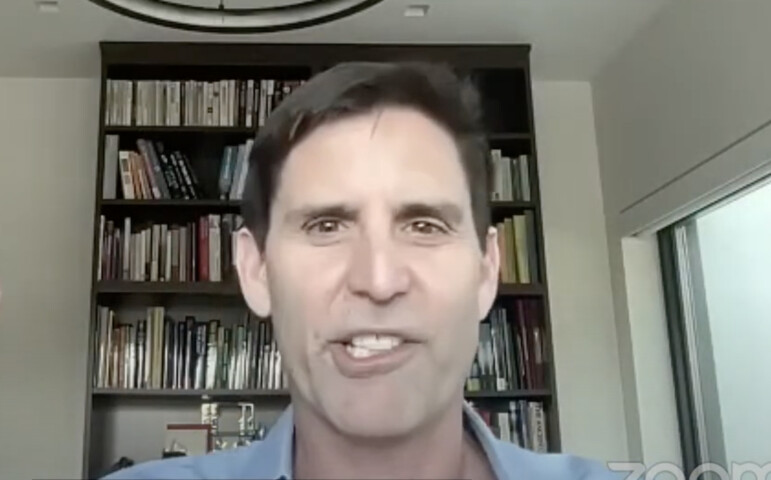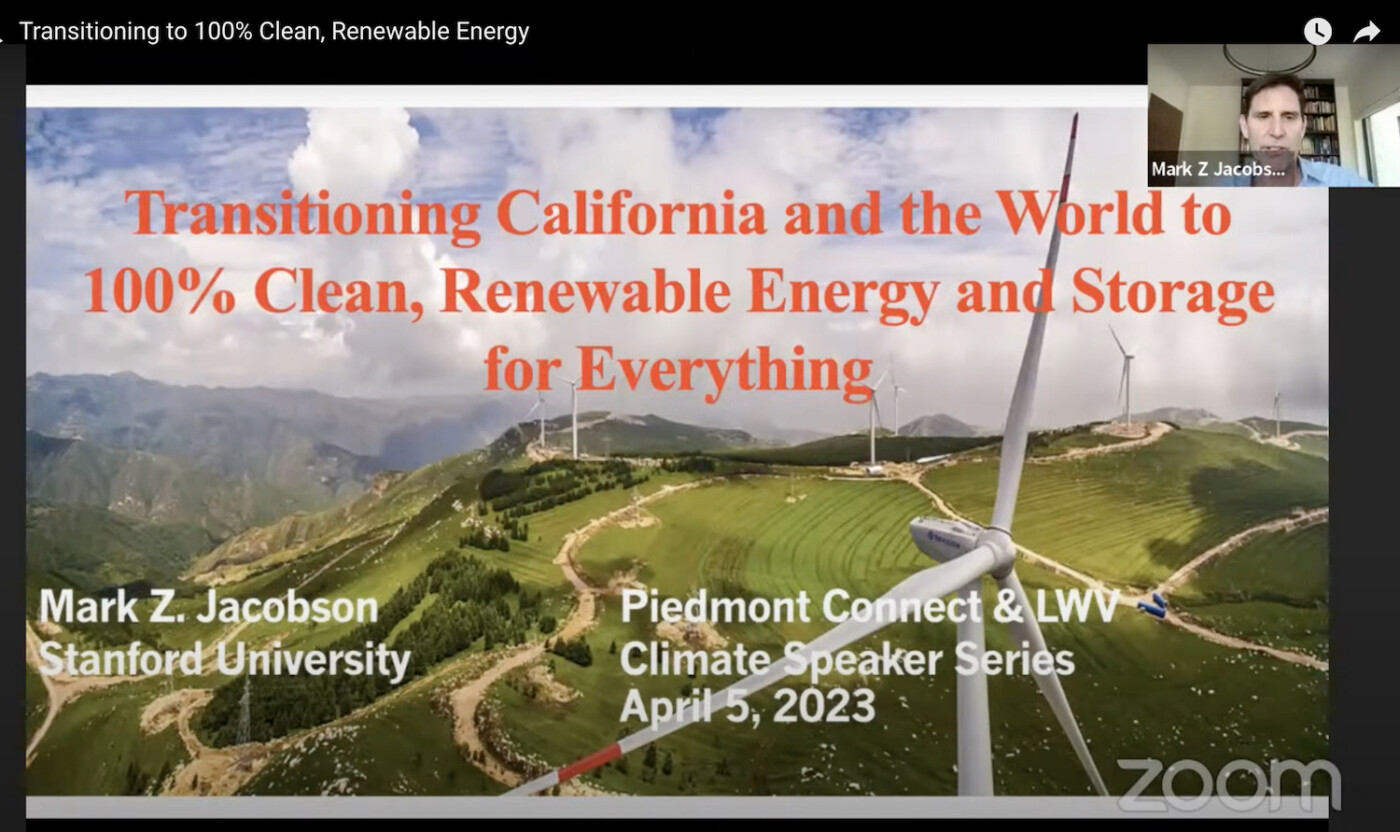The League of Women Voters of Piedmont and Piedmont Connect on April 5 offered the sixth and final event in their jointly offered 2022-23 Climate Speaker Series. April’s lecture and discussion by award-winning scientist, author, and Stanford professor Dr. Mark Jacobson centered around the technologies and actions needed to provide 100% of the world’s energy with clean and stable renewable energy.
Jacobson began by describing his perspective on the problem: Air pollution from burning fuels causes 7 million deaths every year at an annual cost of $30 trillion. In addition, the costs of climate disruption – from wildfires, extreme weather, ocean acidification, vector-borne diseases, agricultural shifts, and rising sea levels, for instance – are expected to rise each year, taking another $30 trillion out of our pockets every year by 2050.
Furthermore, inherent fossil fuels industry dynamics will lead to increasing levels of social instability and geopolitical conflicts.
Thus, using fossil fuels is costly, destabilizing, and ecologically ruinous. According to the global scientific consensus developed by the United Nations’ Intergovernmental Panel on Climate Change, we need to reduce carbon emissions 80% by 2030 and 100% by 2050 to prevent a global average temperature rise over 1.5C. Electric appliances are much more energy efficient than their fossil- or biofuel-burning equivalents. For example, electric heat pumps use one quarter the energy of natural gas furnaces and water heaters. Similarly, electric vehicles are four times more efficient than internal combustion engines. Moreover, consider that 11.3% of all global energy use is expended to mine, refine, and transport fossil fuels, and uranium.

Jacobson helped to shed light on the various existing technologies which are available and in use to power heavy industry, provide long-haul transportation, and store power for future use. Many of us have heard that hydrogen fuel cells can be used for air travel, shipping, long-haul trucking, and military transports when battery EVs become less viable. However, many are unclear on the rainbow used to describe how hydrogen is isolated and compressed into a fuel. Jacobson demystified this hydrogen color spectrum, explaining that only green hydrogen is a solution to the climate crisis and that so-called pink, turquoise, blue, gray, brown, and black hydrogen all use dirty energy to form hydrogen. Only green hydrogen, or hydrogen produced from renewable energy sources, is a fuel compatible with retaining stable climate conditions.
Addressing carbon and direct air capture promoted as a common greenwashing technology, Jacobson explained that both only remove carbon dioxide from fossil-fuel exhausts and do not capture any other harmful toxic emissions. There are therefore no health benefits provided by carbon or direct air capture systems. Moreover, they are expensive and ineffective. Capture equipment requires 30% more energy to run. Therefore, for example, a coal- or natural gas-burning power plant would need to burn 30% more coal or natural gas – creating 30% more air pollution in the process – in order to produce the same amount of electric power. It’s much more cost- and energy-efficient to produce electricity from solar, wind, or water sources. Even more stupefying, Jacobson revealed that 75% of the carbon dioxide that is captured worldwide today is used for “enhanced oil recovery” where the carbon dioxide is piped to oil fields where it is combined with crude in order to lighten it so that it rises to the surface faster. As it rises to the surface, 40% of the previously “captured” carbon dioxide is immediately emitted into the atmosphere again.*
Jacobson lamented that federal taxpayer subsidies from the Inflation Reduction Act can be used to pursue carbon- and direct air-capture technologies: if our taxpayer-funded subsidies were instead used to build renewable energy generation instead of carbon capture from fossil power sources, more carbon dioxide and air pollution would be reduced for the same amount of power generated. He pointed out that there’s never a case where carbon or direct air capture or “blue” hydrogen are beneficial.
“They are scam technologies. They do not do anything for climate, air pollution, or eliminating fossil fuels,” Jacobson said.
He had the same science-based conclusion about so-called energy crops (for example, corn grown to make ethanol, one of many “biofuels” which can be burned in ICEs or mixed into aviation fuels).
Jacobson reported that solar photovoltaics are 20% efficient whereas photosynthesis is 1% efficient. Therefore, one gets 20 times more energy by putting solar panels on an acre of land rather than growing energy crops. Combining the land inefficiency with ICE inefficiency means one could drive 80 times further using land for solar panels to generate electricity and driving an EV than one would be able to drive growing corn to make ethanol to burn in a combustion engine. And one would generate no toxic air pollution in the former scenario.
When asked about nuclear power as a clean energy option, Jacobson once again simplified the math. He said that the capital costs are 15 times higher and lead time 15 years longer to bring nuclear plants into operation in contrast to the capital costs and lead time to bring an equal amount of new solar and wind power generation into operation. The result is nuclear power which costs eight times more over time than the equivalent wind or solar and, Jacobson cautioned, doesn’t account for the issues of weapons proliferation, nuclear waste, underground uranium mining, and meltdown risk which nuclear power introduces.
Commenting on policy recommendations for solving the climate crisis, Jacobson remarked that Renewable Portfolio Standards are the most effective policy tool, where an increasing share of energy in every sector (transportation, aviation, industry, and so on) would be required to be renewable until gradually reaching 100%. This reduces air toxins because it reduces combustion sources. A carbon tax, in contrast, allows industries to pay and continue to pollute. He reiterated that polluting industries can also use scam technologies like carbon capture and so-called “blue” hydrogen to evade any real action which would deliver meaningful results.
As for solar geoengineering – any technique used to reduce the amount of solar radiative energy reaching the earth’s atmosphere – as a potential solution, Jacobson served a blunt warning: “The problem is burning things – we need to stop the burning,” he said. “We need to stop the problem, not mask it – that’s the key,” he added.
*Jacobson reported that only one U.S. coal-fired power plant, located in Texas, had been fitted with carbon capture equipment. Using head-scratching logic, the coal-burning power plant built a natural gas-burning power plant next door to generate the extra electricity needed to run the coal-plant’s carbon-capture equipment at a cost of $1 billion – and the cost was loaded onto the electric utility’s ratepayers. (The carbon dioxide from the natural gas-burning plant was released freely into the atmosphere and not captured.) Due to the cost-inefficiency of this model, the plant closed after three years but its [low-income] rate payers were still stuck covering the cost of the abandoned carbon capture infrastructure.
For even more detail, watch the recordings of all six events in the Piedmont League’s and Piedmont Connect’s Climate Speaker Series on the LWVP YouTube Channel.


